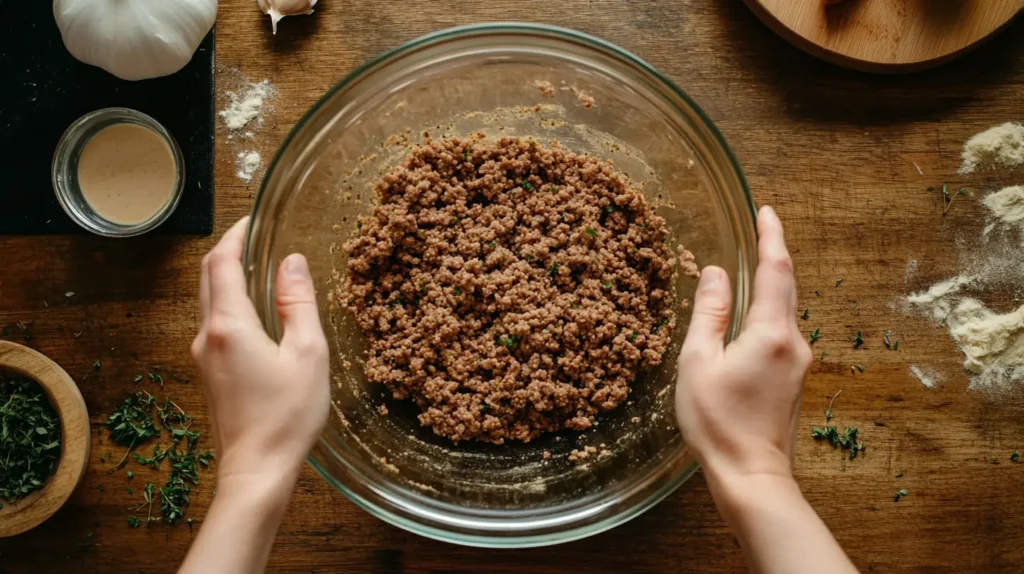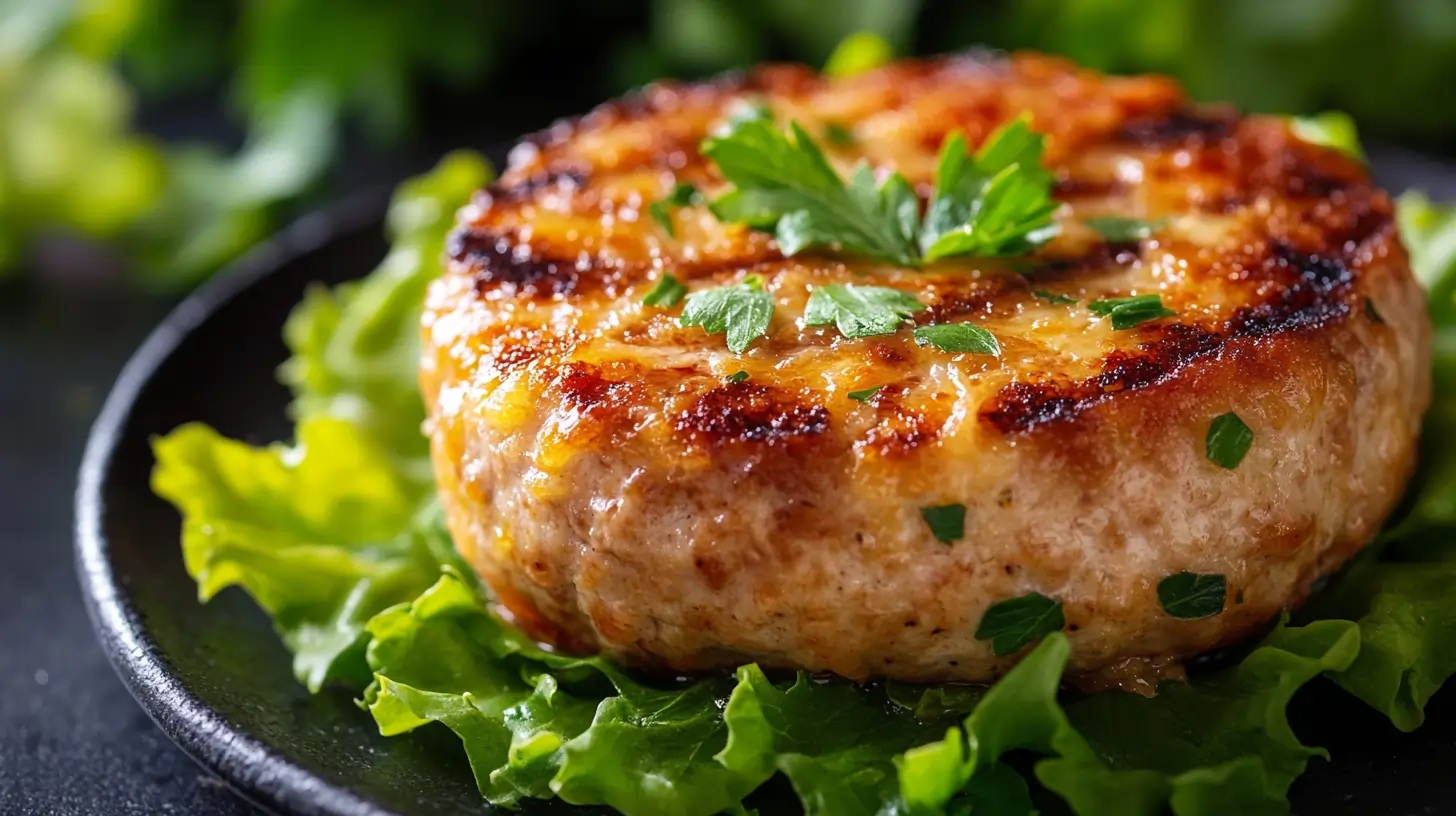Introduction to Juicy Burger Bowl Patties
Juicy burger bowl patties are the heart of this healthier and creative twist on traditional burgers. These bowls deliver the same great flavors but skip the bun. The patty is the star of the dish, and its juiciness and taste can make or break the experience. Whether you use beef, turkey, or plant-based options, mastering juicy patties is essential for delicious burger bowls.
Why Juicy Patties Matter for Burger Bowls
- Better Flavor: Juicy patties add rich and satisfying flavors. They pair perfectly with the fresh ingredients in a burger bowl, like vegetables and dressings.
- Perfect Texture: A moist patty gives a tender bite that balances well with crunchy or creamy toppings.
- More Enjoyable: Dry patties can ruin the meal. Juiciness makes the dish enjoyable and memorable.
- Great Versatility: Juicy patties work with all kinds of meat or plant-based choices. They suit different tastes and diets.
Common Challenges in Achieving Juicy Patties
- Overcooking: Cooking too long dries out the patties and makes them crumbly.
- Low Fat Content: Lean meats or plant-based options often lack the fat needed for moisture.
- Poor Seasoning: Not enough seasoning or using dry ingredients can make patties bland.
- Wrong Cooking Method: High heat or improper techniques can cause moisture loss.
- Binding Issues: Without binders like eggs or breadcrumbs, patties may fall apart and lose juiciness.
Making juicy patties requires the right methods and ingredients. You can retain moisture by using the right fat content, seasoning, and cooking techniques. Keep it simple and flavorful for the best results.
Ditch Dinner Stress — Cook Smart, Not Hard 🍽️
35 quick & budget-friendly 5-ingredient dinners to save your evenings. Simple. Delicious. Ready in 30 minutes or less.
Ingredients for a Juicy Burger Patty

Choosing the Right Ground Meat (Beef, Turkey, or Alternatives)
Selecting the right type of ground meat is the foundation of a juicy burger patty. For beef, opt for ground chuck or blends labeled as 80/20 (80% lean meat and 20% fat). This balance ensures both flavor and moisture. For turkey, go for dark meat blends rather than lean breast meat to prevent dryness. Plant-based options like lentils, black beans, or store-bought alternatives can also create delicious patties if combined with ingredients that retain moisture.
Ideal Fat Content for Flavor and Juiciness
Fat content plays a crucial role in delivering a juicy patty. For traditional beef patties, a fat ratio of 15-20% is ideal. Turkey patties benefit from added fat sources, such as olive oil or grated vegetables, to maintain moisture. For plant-based patties, include fats like coconut oil, avocado, or nuts to enhance texture and flavor without compromising juiciness.
Essential Seasonings for Moisture Retention
Seasonings not only add flavor but also help lock in moisture. Salt should be added right before cooking to avoid drawing out moisture prematurely. Combine it with pepper, garlic powder, onion powder, and paprika for a classic flavor profile. For a unique twist, consider adding soy sauce, Worcestershire sauce, or Dijon mustard. Breadcrumbs or oats mixed with eggs can act as a binder and help the patty hold its shape while staying tender.
Preparation Techniques for Juicy Patties
Properly Shaping and Handling the Patty
Shaping the patty correctly is key to ensuring it cooks evenly and retains its juiciness. Start by forming the patties with gentle hands to avoid compacting the meat. Press the center slightly to create a shallow indentation; this prevents the patty from puffing up during cooking. Aim for a uniform thickness to ensure even cooking, and make the patties slightly larger than the bun or bowl base, as they will shrink during cooking.
How to Avoid Overworking the Meat
Overworking the meat can lead to tough, dry patties. Mix ingredients just until combined, whether you’re using beef, turkey, or plant-based mixtures. Resist the urge to knead or squeeze the mixture excessively. When shaping the patties, handle them gently and avoid pressing too hard. Minimal handling helps preserve the natural texture of the meat and keeps the final result tender and juicy.
Cooking Secrets for Maximum Juiciness
The Role of Heat: Medium-High vs. High Heat
Choosing the right heat level is essential for juicy patties. Medium-high heat is ideal for cooking patties evenly while forming a flavorful crust (the Maillard reaction). It allows the center to cook through without drying out the exterior. Avoid high heat, as it can quickly scorch the outside while leaving the inside undercooked or dry. Using medium-high heat ensures better moisture retention and a perfectly cooked patty.
Importance of Not Pressing the Patty While Cooking
It’s tempting to press the patty with a spatula while it’s on the grill or skillet, but this is a mistake. Pressing forces out the juices, leaving the patty dry and less flavorful. Instead, let the patty cook undisturbed for the recommended time on each side. Trust the process—juices will redistribute and stay locked in if you avoid pressing.
Tips for Flipping the Patty Without Losing Juices
Flipping the patty at the right time and with care helps maintain juiciness. Only flip once during cooking, preferably after the patty has developed a good sear and easily releases from the cooking surface. Use a wide, flat spatula for support to avoid breaking the patty. A gentle, quick flip prevents juices from spilling out or the patty from crumbling. Additionally, avoid piercing the patty with a fork or sharp tool, as this will allow juices to escape.
Additions to Enhance Juiciness
Mixing Breadcrumbs or Panko for Retaining Moisture
Incorporating breadcrumbs or panko into the patty mixture is an excellent way to lock in moisture. These ingredients act as tiny sponges, absorbing and holding the natural juices during cooking. They also help maintain the patty’s structure, preventing it from falling apart while keeping it tender.
Adding Liquid Ingredients like Worcestershire Sauce or Beef Broth
Liquid additions like Worcestershire sauce, beef broth, or even soy sauce add both moisture and depth of flavor. These liquids blend into the meat and help keep the patty juicy as it cooks. A tablespoon or two is usually enough to enhance the texture without making the mixture too wet.
Resting the Patty for Juiciness
Why Resting Helps Redistribute Juices
Allowing the patty to rest after cooking is essential for juiciness. During cooking, juices are pushed toward the center of the patty due to heat. Resting lets the juices redistribute evenly throughout the meat, ensuring each bite is moist and flavorful.
Optimal Resting Time After Cooking
Let the patty rest for 3–5 minutes after removing it from the heat. Cover it loosely with foil to keep it warm while allowing the juices to settle. This brief resting period makes a noticeable difference in juiciness without letting the patty cool too much.
Avoiding Common Mistakes That Lead to Dry Patties
Overcooking or Using Too High Heat
Overcooking dries out the patty and eliminates its natural juices. Stick to medium-high heat and monitor cooking time closely. Use a meat thermometer to ensure the internal temperature reaches about 160°F (71°C) for beef and 165°F (74°C) for turkey or chicken. Cooking beyond these temperatures can result in dryness.
Using Lean Meat Without Adjustments
Lean meat, such as ground turkey breast or extra-lean beef, lacks the fat needed for juiciness. To compensate, mix in moisture-boosting ingredients like olive oil, grated vegetables, or breadcrumbs. Alternatively, choose ground meat with a slightly higher fat content to ensure a tender and flavorful patty.
Tips for Customizing Burger Bowl Patties
Incorporating Cheese Directly Into the Patty
Mixing cheese into the patty is a creative way to enhance both flavor and juiciness. Shredded cheddar, mozzarella, or pepper jack are popular choices that melt beautifully during cooking, creating a gooey texture. You can also try cubing the cheese and folding it into the meat mixture for bursts of flavor. Be sure to distribute the cheese evenly and avoid overmixing to maintain the patty’s texture.
Adding Herbs and Vegetables for Moisture and Flavor
Fresh herbs like parsley, cilantro, or thyme can elevate the flavor of burger patties. Additionally, grated or finely chopped vegetables such as onions, zucchini, or mushrooms contribute moisture and prevent dryness. These ingredients not only enhance juiciness but also add a nutritional boost. For best results, squeeze excess water from vegetables like zucchini before mixing them into the meat. This ensures a perfect balance of moisture without making the patty too soft.
FAQs About Juicy Burger Patties
Can I Use Frozen Meat for Juicy Patties?
Yes, you can use frozen meat, but for the juiciest results, it’s better to thaw it properly first. Cooking frozen patties can lead to uneven cooking, where the outside may dry out while the inside remains undercooked. Thaw meat in the refrigerator overnight to retain its natural moisture. If you’re short on time, use the microwave’s defrost setting, but avoid overcooking the edges during thawing.
What’s the Best Fat-to-Meat Ratio for a Juicy Patty?
For beef patties, the ideal fat-to-meat ratio is 80/20, meaning 80% lean meat and 20% fat. This balance provides enough fat to keep the patty moist while avoiding excessive grease. For turkey or chicken patties, choose blends that include dark meat or add fat-enhancing ingredients like olive oil or grated vegetables. Plant-based patties can benefit from adding small amounts of healthy fats like avocado or coconut oil for improved texture and flavor.
Closing Thoughts
Why Juicy Patties Are Essential for Burger Bowls
Juicy patties are the heart of a great burger bowl. They provide the rich flavor and tender texture that balance the fresh, crunchy, and creamy elements of the dish. A dry patty can undermine the entire experience, while a perfectly juicy one ties everything together, making each bite satisfying and memorable.
Encouragement to Experiment with Techniques and Ingredients
Creating the perfect juicy patty is both an art and a science, but it’s also an opportunity to get creative. Experiment with different meats, fat ratios, seasonings, and add-ins like cheese or herbs to discover your signature style. Don’t be afraid to try new cooking methods or customize ingredients to suit your taste. With the right techniques, you can craft burger bowl patties that are not only juicy but also uniquely yours.
Resources and Further Reading
For readers looking to dive deeper into related culinary tips, recipes, and techniques, here are some resources from Quick’n Recipes that can complement your knowledge about crafting juicy burger bowl patties:
- Burger Bowl Recipe: Healthy and Customizable: Discover how to create a complete and customizable burger bowl, perfect for pairing with your juicy patties.
- What Not to Do on a Blackstone Griddle: A guide to avoiding common cooking mistakes that can impact the quality of your patties.
- Can You Use Egg Whites in Burgers?: Explore how egg whites can be used in patties to enhance texture and moisture.
- Easy Dense Bean Salad Recipe: Nutritious & Delicious: A perfect side dish to complement your burger bowls.
- What Is the Healthiest Oil to Cook With?: Learn about the best oils for cooking patties without compromising health or flavor.
- Top Smoker Recipes and Tips for Perfect Smoked Dishes: Explore how smoking techniques can be adapted for unique patty flavors.
- Adding Sour Cream to a Box Cake Mix: Benefits and Tips: While not directly related, this article provides insights into moisture-retaining techniques that may inspire your patty recipes.
These articles provide a mix of practical tips, creative inspiration, and complementary recipes to elevate your burger bowl experience. For more, explore the full collection at Quick’n Recipes.
